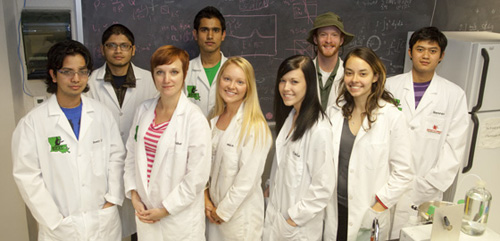SEAL project links students with industry
On the home page:
Click on the thumbnail for a larger picture.
Arjun Pandey, right, explains a process he is using in one of the SEAL research projects to, from left, David Norwood, SEAL Student Manager Amber Bordelon, and Jean Fotie. Norwood and Fotie are two of the faculty mentors who work with the SEAL project.

Southeastern students involved in the SEAL project include, front row, from left:
Sumit Libi, Amber Bordelon, Jessican Rhodus, Carla Rohner and Ciera Thrash; back row,
from left, Bijay Bhattarai, Arjun Pandey, Patrick Floweres, Saurav Malla.
Amber Bordelon, Robert, SEAL Student Manager
David Norwood, Ph.D., Associate Professor of Physics
In a Southeastern chemistry lab, students are not only impressing their professors with their work but also are catching the attention of Louisiana chemical companies through a program that links students with industrial research.
The students are part of SEAL, a student-run organization working on projects proposed to them by area industries. SEAL which stands for Student Entrepreneurs as Active Leaders was organized at Southeastern with a post-Katrina grant from the Louisiana Board of Regents. It was created to encourage economic development activity by linking students with area businesses and industries.
This linkage between academia and the workplace is a focus of strategic initiatives at Southeastern as the university prepares students for success in a knowledge-based economy.
“Students work under the guidance of Southeastern faculty members to solve research questions and problems for Louisiana industries,” said David Norwood, the physics professor who sought the original grant and now serves as one of the group’s faculty advisors. “These industries frequently have questions that come up that they may not have the time, equipment or personnel to investigate. They can now turn to our SEAL group and for a nominal fee initiate the research they need.”
Norwood said students seeking a SEAL position submit an application and then are interviewed by student managers who assess their qualifications."
“SEAL allows us to see the kind of work that major corporations are involved in, and we are paid for our work,” said student manager Amber Bordelon of Robert, a senior chemistry major. “The extra money we bring in goes back into the SEAL fund for future work, to purchase supplies and sometimes for travel to make presentations at conferences.”
“This work allows us to do things beyond our regular academic lab studies,” Bordelon says. “It’s a great exposure to the industrial world.”
Among the dozen or so firms the SEAL group has partnered with over the past several years are Gaylord Chemical of Slidell, United States Composite Pipe South in Zachary, V-Labs, Inc. of Covington and Bercen, Inc. of Denham Springs.
“Like most chemical companies, we are always trying to develop new products and conduct research,” said Artie McKim, technical director of Gaylord Chemical’s Research and Technology Center in Bogalusa. “The problem is we don’t have the time or resources to research what we want. The SEAL students have done an excellent job of solving some of our burning questions.”
Bercen, one of the largest producers ofpapermaking chemicals in the world, has also placed several projects with SEAL.
“SEAL helped to characterize some substances that they could possibly use in their coatings,” said Bordelon. “We analyzed the structure and size of the molecules to determine why some worked and some didn’t. We also did some organic synthesis for them, creating new compounds that they could possibly use.”
Bercen chemist Joseph Harrell said the company was definitely pleased with the quality of work performed by the students.
“One of the reasons Bercen moved its headquarters here was to be close to universities like Southeastern that we could partner with,” said Harrell, a 2006 Southeastern graduate. “This is such good training for students, giving them the chance to work on real-world problems. I wish something like this had been available when I was a student.”
In addition to Norwood, chemists Debra Dolliver and Jean Fotie work with the students as faculty supervisors.
“They primarily review our work,” Bordelon explained. “If it’s a new project, they’ll hold our hands and walk us through the steps we are proposing. The faculty advises us, but in the end the students design and execute the project. They are all very patient with us and always accessible and willing to help.”
More Homepage Stories...

